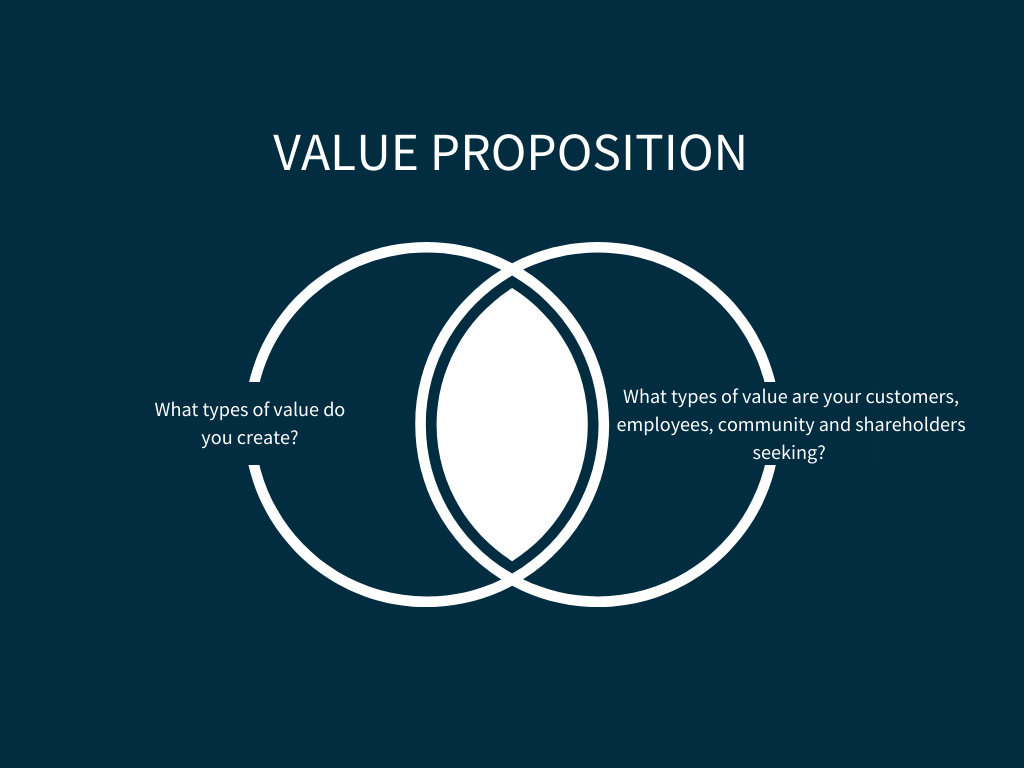During a recent workshop with a client’s board and leadership team, a great question was asked which had everyone in the room stumped. We were discussing the organisation’s purpose (see our article on the importance of purpose here), which we felt was quite well-defined at this point; the purpose related to ‘creating value’ for a particular industry. Then came the question: “so what types of value do we create?” and the room went quiet.
While this question may seem fundamental, in this case the team didn’t have a clear and shared answer. And if the leadership team were unclear, how could we expect to get alignment and a shared understanding of the organisation’s purpose throughout the rest of the business?
The path forward was soon clear – we needed to understand the organisation’s value proposition.
Value propositions
An organisation’s value proposition simply defines who the organisation exists for and how it delivers value to them. It has also been defined as
Products, services or experiences that create desired gains or relieve existing pains.
When we use value propositions, we’re generally less interested in boiling them down into one-line marketing slogans, but instead focussing on making them clear and vivid descriptions of the value you create for different groups. The best value propositions go deep into the problems your organisation solves for people.
Uber, while a very polarising company in general, has one of the best value propositions we’ve come across.

This example from Uber does a great job of demonstrating the pains the company relieves (‘easiness’, particularly compared to traditional taxis) and the gains it creates (convenience and low cost).
Customer value propositions are by far the most common form, however best practice value propositions target all key stakeholder groups, including employees, the community and shareholders.
Why you should know your value proposition
Done well, value propositions are valuable tools for:
- Designing or launching a new product or business, helping the designer or founder to understand the value and viability of their idea.
- Generating strategic alignment throughout your organisation
- Improving the efficiency of your business by being clear on the value your organisation creates and ensuring that business processes are designed to maximise this value.
- Providing clear and vivid descriptions to differentiate your organisation in the market.
In our experience, this last point is often the most important. Potential customers and employees don’t choose one business over another based on vague and high-level mission statements, but on the translation of these into clear and vivid imagery.
One great example of this in practice is the following video from SodaStream, which is essentially a two and a half minute long employee value proposition, explaining why people should work for them.
Hot tips
There’s several different methods for understanding and identifying your value proposition. Before we get into the detailed method, here’s two general tips:
- Not sure which type(s) of value proposition you should try to create/identify (e.g. customer, employee, community or shareholders)? If you are a charity or not for profit, start with community, otherwise start with customer. If in doubt, try them all and see which ones feel strongest.
- If you’re clear on your organisation’s purpose, identifying your value proposition will be easier. If you’re less clear on your organisation’s purpose, don’t worry. Thinking about value propositions is a great way for clarifying purpose – you may be able to kill two birds with one stone.
Defining your value proposition
Our method for defining your value proposition is summarised below.

Steps:
- Identify the types of value YOU believe the organisation creates. This can be done via internal survey/interview or just using your judgement and knowledge. Focus on your organisation’s output, not process. In cafes ‘making coffee’ is not the value they create. Instead, a café may identify that they provide a comfortable space for customers to take a break and enjoy a hot, well-made coffee of their choice at an affordable price.
- For each group that you are developing a value proposition for, identify what important types of value THEY are seeking. Surveys and interviews are likely to be helpful for this step.
- Identify where these two sets of value align/overlap, to connect the types of value that you create which are common with the types of value each group wants. This is likely to be the core of your value proposition for each group.
- ‘Trim the fat’ and prioritise. Which are the most important/unique/different/special types of value we create that each group really wants? Prioritise these. Which types of value did we believe we create, but which don’t appear to align with any stakeholder group’s interests? Trim these.
- Take the prioritised types of value for each group, and draft statement(s) that encapsulates this value proposition.
If you’re looking for an alternative to the method above, a great tool to check out is the Value Proposition Canvas created by Strategyzer – the team best known for their Business Model Canvas. The Value Proposition Canvas has an accompanying book and online course if you want to dive deep.
Go for it!
Understanding your value proposition is impactful, and relatively straightforward once you know how. Give it a crack and let us know how you get on!
Where to go next
- Read our article on the importance of purpose
- We have developed several tools to help managers maximise their impact, including the free Team Alignment Canvas and the Strategic Planning Toolkit